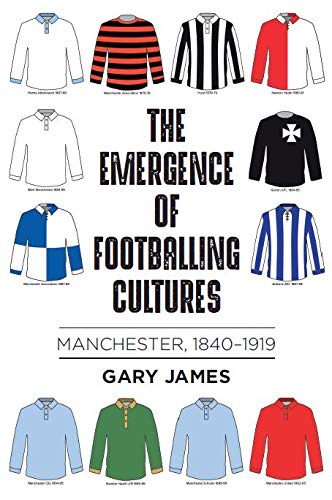

Footballing culture (men’s professional football/soccer) developed in the greater Manchester area from the mid-nineteenth century to the inter-war period. In his work, Gary James identifies eight developmental phases, two of which involved the rival code of rugby. The relationship between the two codes was complex—for example, the third phase involved the founding of the city’s first rugby club and the development of an association football club, Hulme Athenaeum and the fourth phase involved experienced Manchester footballers setting up regular fixtures against teams in Sheffield and Stoke, while a well-established rugby club also formed a soccer team. Indeed, for most of James’s developmental phases, rugby was regarded as the dominant code in the area. He does not claim that the developmental route he plots for Manchester is a model for how football develops elsewhere; however, he does encourage other researchers to use his methodology to study other sites of football’s development, at the level of city, region, or metropolis. His hope is that if they go into the same level of detail and have similar regard for the multiple contexts impacting the issue, then progress will be made in understanding the early days of football in its motherland and further afield.
Aware of what has been written hitherto about the early years of football in Britain, he is not the first historian to express disappointment at the “occasionally unhelpful” and personal nature of critiques emerging as part of the “origins debate” of the last two decades. This began—readers interested in this book will no doubt be aware—when historians researching at the local level called into question the hitherto accepted exclusive role of the “public schools” in developing and diffusing the modern form of the sport to communities within the UK and subsequently abroad. James’s study of the origins of football in greater Manchester avoids coming down on one side or the other of the debate; his history is a much more complex one than that. By the end of the beginning of a recognizable football culture in Manchester, i.e. by 1919, the key individuals developing football there included public schoolboys and also men from the lower-middle class—some from Manchester. Others were experienced enthusiasts from nearby Stoke and Nottingham, and indeed from as far away as Scotland. By 1919, there were two clubs bearing the Manchester name, and a number of other professional clubs existed within the conurbation. Crucially, in 1884, the city managed to get its own Football Association (FA), which organized various leagues and cup competitions at every level including schoolboy football. The hosting of the FA Cup Final in 1893 and Manchester City’s winning of the Cup in 1904 had significantly increased the audience for football in Manchester. As the sport put the First World War behind it, football in Manchester had “crossed the class divides and was most commonly associated with the working classes” (254). In this respect, James makes very interesting use of details, for example, of incomes, costs and prices, to show the diversity of support within stadiums—regarding social class, as well as women supporters and schoolboys. He can even cite the price of tickets in the earliest Manchester Newsreel cinemas showing highlights of the 1904 Cup Final.
Among the important recurrent themes that James brings to the fore is the important developmental relationship between football and the press. The proprietor of Manchester’s Athletic News, Edward Hulton, recognizing the growing audience for local and national sports news and regularly devoting column inches to it, was keen to accept an invitation to become a Director of Manchester City FC—and in 1903 became Chairman. He boasted his Athletic News could deliver newspapers anywhere north of the Midlands hours earlier than his London-based rivals. His money, business acumen and influence make him a key figure in James’s book.
Another recurrent theme is the rivalry between the clubs and the professional Football League, on the one hand, and the sport’s governing body, the FA, on the other. It was partly a geographical issue (north versus south) but also, in the case of Manchester, an administrative one. The locals had to fight hard against the county-based regional structures, knowing as they did that the key economic and commercial area that people recognized (and thus also the key to local identity) was the greater Manchester conurbation, where the tram routes ran to and from. Modern football does appear to have been very early an urban phenomenon and the city crossed county boundaries. The cotton industry and subsequent industrialization had swelled Manchester’s population from 142,026 in 1831 to over 400,000 by 1871. Yet the Manchester clubs had to lobby hard before the national FA agreed to a Manchester & District FA in 1884. By 1901, the wider Manchester region had passed two million. Later, potential conflicts between clubs and the sport’s national governing body were resolved by a small number of key people in the hierarchy of the major clubs becoming represented on the governing body and its key committees, where they exercised great influence (albeit sometimes rather nefariously).
Expectations of encouraging words about the book on the back cover by a famous footballer are more than fulfilled—by Gary Neville as founder of University Academy 92 and Vincent Kompany MBA. However, one would not necessarily expect references to the French Annales School of history in a book by a historian most of whose numerous and successful publications have been aimed at a non-academic audience of football fans and devoted mostly, but not exclusively, to the subject of Manchester City FC. Not on the back cover, but in his Introduction, James nonetheless explains and justifies the ways in which his methodology owes much to Fernand Braudel’s work. Indeed, the author’s use of Braudel to understand the long-term development of football can be seen as refreshingly ambitious and pervades the book.
In his famous article on History, Social Science and la longue durée, Braudel examined what could be gained by historians both from using elements from within neighboring disciplines, and also, particularly, from social historical analysis that went far beyond a series of events presented in chronological order. It is not that Braudel was not interested in time, duration, and order of events. For analytical purposes, he divided time into three shorter and longer periods, and what interested him was looking to understand historical change across social structures, changes that are necessarily deep and long-term. Like Braudel, James makes good use of statistics. The geographical context is also important to both. James deals with the local and the regional and when appropriate relates that perspective to the national. He distinguishes between different districts of Manchester in economic, industrial and social terms, and also between greater Manchester and the smaller Lancashire mill-towns.
However, the most important element in James’s analysis is how he applies Braudel’s approach to historical time to the cultural history of football within the period studied. Believing that “over the long term our collective behavior is established alongside our enduring social structures,” while the cyclical or medium term includes periods of major change, James has developed a whole framework adapted from Braudel’s. His jokey metaphor for the longue durée is “full-time.” While useful as an initial introduction of the concept, it is perhaps just as well that he uses mainly thereafter the original French term to refer to the complete period or full-time history of football (so far), within which the historian needs to be able to contextualize events and their significance over the life of the sport. His use of the term transformational level for Braudel’s medium-term period is well chosen to indicate the structure of his analysis of change within the book, as opposed to basing his structure on headline-grabbing events. For the short-term “events” level he coins the term episodal level, which allows him to show the lesser importance of events whose significance are not fixed but open to interpretation in the overall picture of historical change. In this context, he finds greater significance than previous accounts in the short lifetime of the Hulme Athenaeum club through the community and networks that developed via the club, of which one founding member was still playing a leading role in the development of football in the region thirty years later. Using his three-fold time framework, he presents a new detailed understanding of the development of football culture in greater Manchester by his close analysis of how relationships, interdependencies, myths, successes, and institutions were formed.
Finally, two technical comments need to be made to do with how researchers might use this book. The Index will certainly be useful to find references to people, places, clubs, and competitions, but it could have been even more usable for researchers by the inclusion of thematic entries, such as governance, legislation, working hours, corruption, alcohol, fans, social class, fields of play, goalposts and bars, rules/codification, and rivalry with rugby—James has interesting things to say about all of these. The chapter titles do help to some extent, but not where a theme crops up throughout the book. An academic press should realize too that sole reliance on the copious end-of-chapter notes does not make up for the lack of a separate alphabetical bibliography.
That said, researchers on the early history of football as a whole, not just on its origins in the north-west of England, will not be able to ignore this book. Through its framework and careful use of often new archival material, it tells a powerful and persuasive story of the development of sport in the greater Manchester area, rescuing from oblivion some important historical actors. Writing on the role of the FA or of the south-east of England in any future top-down approach to the history of the development of football will have to take account of municipal and regional agency, for example the powerful influence exerted on the governing body by club and Football League officials, especially via membership of key FA committees. Indeed, what would be more useful in the immediate future is detailed archival research on the origins of football at the local level in other major urban areas. James’s book would appear to come at an important historical moment, perhaps a tipping point, in the broader relationship of the Manchester metropolitan area to the rest of England, and of North to South, but, of course, only the longue durée will tell.
Geoff Hare is a retired academic living in Edinburgh, Scotland. He worked mainly in Newcastle University (UK) in the School of Modern Languages, for a time as Head of School. He has published widely on media and sport in France, notably the book, Football in France: A Cultural History (Berg, 2003).
The Emergence of Footballing Cultures, Manchester, 1840–1919
By Gary James
Publisher: Manchester University Press
Hardcover / xii + 263 pages / 2019
ISBN: 978 1 5261 1447 1
Published on August 4, 2020.




